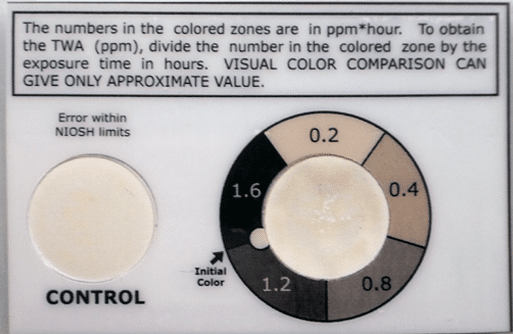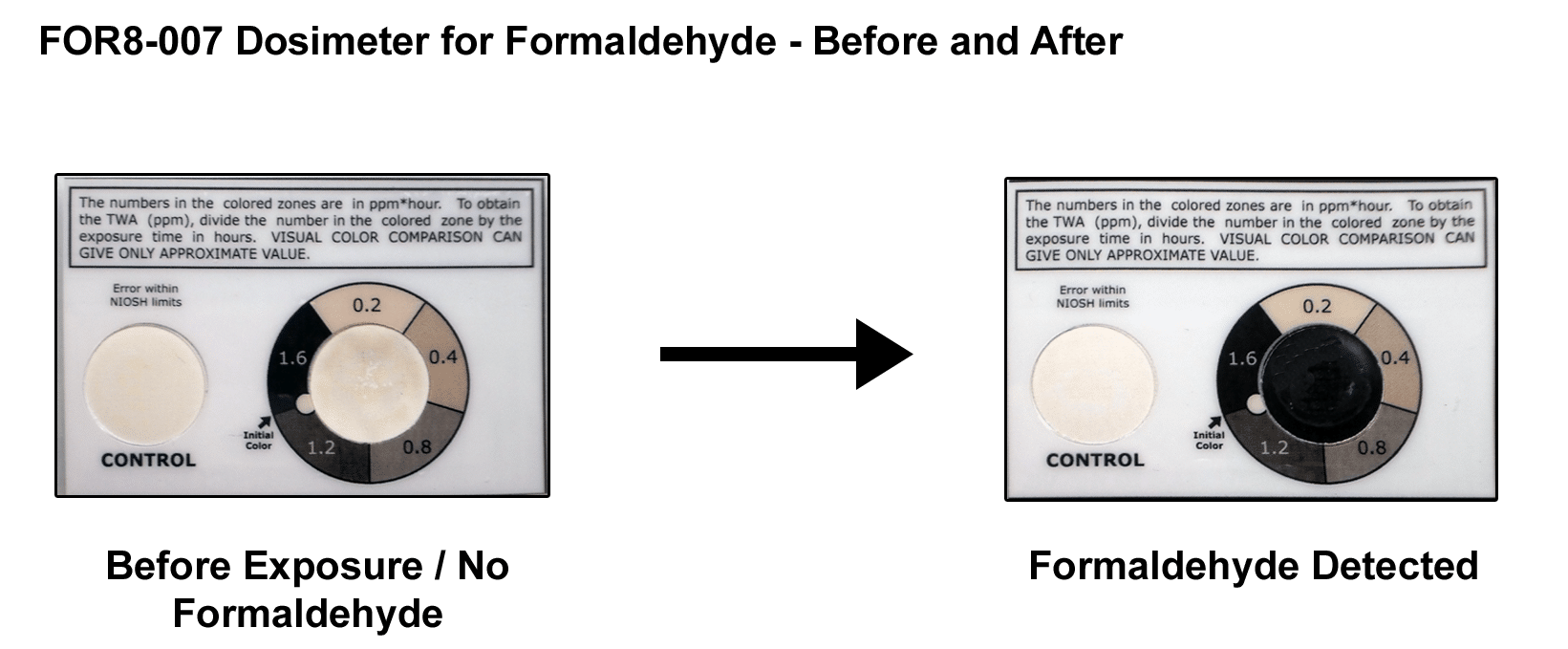Overview
ChemSee’s has available small, lightweight badge dosimeters for monitoring exposure to Formaldehyde. This dosimeter uses a simple color change to estimate the total exposure dose to Formaldehyde.
The FRM-KT1 Formaldehyde Dosimeter uses a simple color change to estimate the total exposure to Formaldehyde. They can be fixed to a person with a clip or placed in a room to monitor / record levels present.
Product Description and Use
Dosimeters are placed in suspect areas for 24-72 hours with back side exposed to the air. After the allotted time, the color formed on the front of the dosimeter is compared to the printed color reference to obtain a semi-quantitative exposure. Additionally, the dosimeters can be checked at regular intervals throughout the day to ensure exposure levels comply with government regulations.
The dosimeter detects Formaldehyde in the range of 0 to 1 ppm*hr. To determine the total exposure of the indicator to Formaldehyde, compare the color formed during testing to those provided on the dosimeter. Divide the ppm*hr value on the card by the total exposure time (in hours) to determine the average amount of Formaldehyde is the air during the trial period.
Free Quantitative Analysis
We now offer free quantitative readings emailed to you if the dosimeters are sent back to our laboratory for analysis. To take advantage of this offer, the dosimeters should be sealed, with all of the air removed, after testing is complete and sent back to our office with the filled out log sheet at:
ChemSee / Appealing Products, Inc.
Att: Sample Analysis
6003 Chapel Hill Road, Suite #177
Raleigh, NC 27607, USA
Please be sure to enclose contact information such as Name, Email Address and Phone Number.
Kit Contents
- 2, 5 or 10x FRM-KT1 Formaldehyde Dosimeters
- 1x Color Instructions
- Log Sheet
- Instructions on the Free In-Lab Sample Analysis
Detector Features
- Semi-Quantitative Visual Analysis
- Meets and Exceeds Standards/Requirements Set by OSHA
- Free Sample Reading
- Electronic Reader Available for bulk purchases
- Detection Range of 0 to 1 ppm*hr
- Small and Lightweight (Size of a Credit Card)
More Information
Formaldehyde is an organic compound with the formula CH2O. A gas at room temperature, formaldehyde is colorless and has a characteristic pungent, irritating odor. In view of its widespread use, toxicity and volatility, exposure to formaldehyde is a significant consideration for human health. On 10 June 2011, the US National Toxicology Program described formaldehyde as “known to be a human carcinogen”.
Formaldehyde is highly toxic to all animals, regardless of method of intake. Ingestion of as little as 30 mL (1 oz.) of a solution containing 37% formaldehyde has been reported to cause death in an adult human. Water solution of formaldehyde is very corrosive and its ingestion can cause severe injury to the upper gastrointestinal tract.
Occupational exposure to formaldehyde by inhalation is mainly from three types of sources: thermal or chemical decomposition of formaldehyde-based resins, formaldehyde emission from aqueous solutions (for example, embalming fluids), and the production of formaldehyde resulting from the combustion of a variety of organic compounds (for example, exhaust gases). Formaldehyde can be toxic, allergenic, and carcinogenic. Because formaldehyde resins are used in many construction materials it is one of the more common indoor air pollutants. At concentrations above 0.1 ppm in air formaldehyde can irritate the eyes and mucous membranes, resulting in watery eyes. Formaldehyde inhaled at this concentration may cause headaches, a burning sensation in the throat, and difficulty breathing, and can trigger or aggravate asthma symptoms.

